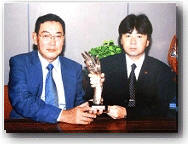Takasago Received The Molecular Chirality Awards 2002

The Molecular Chirality Award 2002 was awarded to Takasago International Corporation for its contribution to innovations in Catalytic Asymmetric Synthesis, including the development of SEGPHOS-Ru (II) catalyst. At the ceremony, the award was presented to Dr. Hidenori Kumobayashi (Senior Vice President for Fine Chemical Division) and Dr.Takao Saito (Director of Fine & Aroma Chemical Research Laboratory), delegates from the Fine Chemical Division and the Research Laboratory.
Takasago International Corporation, the first company to manufacture synthetic fragrances in Japan, was founded in 1920. Takasago scored first in 1983, when it became successful in the industrial production of l-menthol by the Asymmetric Synthesis with BINAP-Rh (I) complex. This success led the fine chemical maker in becoming the specialist of "Catalytic Asymmetric Synthesis". Since then, Takasago has taken advantage of their original technology based on Asymmetric Synthesis as the core technology, industrializing various products including acetoxyazetizinone (4AA : a key intermediate for carbapenem antibiotics), propanediol (PPD : an intermediate for a new quinolone antibacterial agent), a chiral part for anti-AIDS drugs, etc.
Not satisfied with the success of BINAP, they devoted themselves in making more innovations in asymmetric catalysis throughout the period. One of the representative, results was the development of a chiral ligand for new generation called SEGPHOS, (4,4'-bi-1,3-benezodioxole)-5,5'-diyl-bis-(dipheneyl-phosphine). The ligand was designed based on the idea that narrower dihedral angle of biaryl framework should give better enantioselection.
SEGPHOS-Ru complexes, estimated to have narrower dihedral angle than that of BINAP, often surpass BINAP complex both in catalytic activity and enantioselectivity. The excellent chiral recognition ability of SEGPHOS-Ru complex catalyst can be demonstrated by the hydrogenation of 2-oxo-1-propanol to afford propenediol, which is a chiral building block of new quinolone antibacterial agent, in 99% ee and with >10,000 turnover number (BINAP, 89% ee, S/C=3,000).Under dynamic kinetic resolution conditions, the ruthenium complex of DTBM-SEGPHOS, one of SEGPHOSes, reduces the carbonyl group of racemic methyl 2-benzamidomethyl-3-oxobutanoate to one enantiomer among four possible isomers in >98% de and >99% ee (BINAP, 86% de, 98% ee). For this conversion, a turnover number of 5,000 is achieved.
With the new catalysts replacing BINAP counterparts, Takasago is planning to expand its business in manufacturing intermediates for various kinds of medicines: especially antihyperlipemia, antibacterial, antibiotics, anti-depressant and drugs for diabetes mellitus, pollakiuria, osteoporosis and AIDS.
BINAP is compared to a butterfly for its high ability and beautiful structure. SEGPHOS is named after a seagull, which flies higher and faster than a "butterfly".
Takasago International Corporation, the first company to manufacture synthetic fragrances in Japan, was founded in 1920. Takasago scored first in 1983, when it became successful in the industrial production of l-menthol by the Asymmetric Synthesis with BINAP-Rh (I) complex. This success led the fine chemical maker in becoming the specialist of "Catalytic Asymmetric Synthesis". Since then, Takasago has taken advantage of their original technology based on Asymmetric Synthesis as the core technology, industrializing various products including acetoxyazetizinone (4AA : a key intermediate for carbapenem antibiotics), propanediol (PPD : an intermediate for a new quinolone antibacterial agent), a chiral part for anti-AIDS drugs, etc.
Not satisfied with the success of BINAP, they devoted themselves in making more innovations in asymmetric catalysis throughout the period. One of the representative, results was the development of a chiral ligand for new generation called SEGPHOS, (4,4'-bi-1,3-benezodioxole)-5,5'-diyl-bis-(dipheneyl-phosphine). The ligand was designed based on the idea that narrower dihedral angle of biaryl framework should give better enantioselection.
SEGPHOS-Ru complexes, estimated to have narrower dihedral angle than that of BINAP, often surpass BINAP complex both in catalytic activity and enantioselectivity. The excellent chiral recognition ability of SEGPHOS-Ru complex catalyst can be demonstrated by the hydrogenation of 2-oxo-1-propanol to afford propenediol, which is a chiral building block of new quinolone antibacterial agent, in 99% ee and with >10,000 turnover number (BINAP, 89% ee, S/C=3,000).Under dynamic kinetic resolution conditions, the ruthenium complex of DTBM-SEGPHOS, one of SEGPHOSes, reduces the carbonyl group of racemic methyl 2-benzamidomethyl-3-oxobutanoate to one enantiomer among four possible isomers in >98% de and >99% ee (BINAP, 86% de, 98% ee). For this conversion, a turnover number of 5,000 is achieved.
With the new catalysts replacing BINAP counterparts, Takasago is planning to expand its business in manufacturing intermediates for various kinds of medicines: especially antihyperlipemia, antibacterial, antibiotics, anti-depressant and drugs for diabetes mellitus, pollakiuria, osteoporosis and AIDS.
BINAP is compared to a butterfly for its high ability and beautiful structure. SEGPHOS is named after a seagull, which flies higher and faster than a "butterfly".